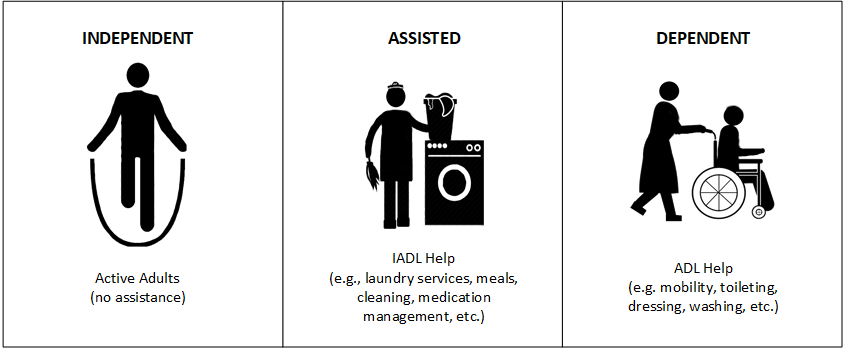Laws Governing Age Restricted Senior Living Communities
Click here to see what's on this page.
In response to the 60s move toward fairness and equality, the government sought ways to prevent housing discrimination. Consequently, the federal government passed Title VIII of the Civil Rights Act of 1968. It was called the Fair Housing Act the law, and its amendments, prohibit discrimination in the sale, rental, and financing of dwellings based on race, color, religion, sex, national origin, disability, and family status (age, presence of children, pregnancy, etc.). However, the law provided exceptions for age-restricted communities.

Administration and enforcement of the law is by the US Department of Housing and Urban Development (HUD). When it comes to age, there are a few exceptions to the non-discrimination laws.
There are two qualifying age categories for developers or managers of senior living communities. One requires all residents be age 62 or older. The other is that at least one resident in 80% of the units is 55 or older.
Value Of Senior Communities
Senior only, or age-restricted living communities, have value to the residents and the developer (or community owner). The most obvious is the ability to restrict by age. Segments of seniors, and developers (and managers of these developments) like the ability to age restrict. Seniors for example may like the idea of living in an adult community. They may believe it’s quieter, safer, and more conducive to their lifestyle and needs. Developers may like the ability to target older residents and offer services and amenities they believe specifically address their needs and desired lifestyle.
Before discussing what these communities offer, keep in mind CarePlanIt’s IAD model of housing. You can read about it in detail here. The diagram below sums it up.

Seniors face unique challenges like impaired vision, loss of community/work (detachment), impaired hearing, decreasing physical strength, and a desire for predictability. Housing developers and community managers, believe targeting amenities and services that address these and other needs allows them to create desirable senior living communities. Age-restricted communities often offer the following:
What Age Restricted Communities Can Do That Others Cannot
A legally defined age-restricted senior community can better manage traffic, noise, parking, and activities. Many seniors want a more predictable and manageable environment than what a non-senior community can offer. They feel safer in more controlled environments.
Here are a few simple examples. Many seniors have challenges driving cars but can manage a golf cart. In most communities, getting approval to use your golf cart on the roads wouldn’t be allowed. There are too many safety concerns because the diverse population and goals of these residences don’t align. In a senior community, you have less diversity and don’t care as much about younger people getting to work, or having to drive at slower speeds, or sharing giving right-of-ways. Another example is lighting. In a senior community, you can require extensive lighting for safety that other communities wouldn’t allow. In senior communities, expectations and needs are shared. Goals can be focused on those expectations and needs. A developer can focus on these.
In addition to the above, an age-restricted housing developer or community manager can also limit occupancy to people over a certain age and deny long-term occupancy to children. Other restrictions like noise requirements, community lighting objectives, community speed restrictions, and vehicle restrictions can match senior preferences. Think well-lit communities with forms of curfews (noise restrictions, no parties after midnight, etc.).
Fair Housing and Equal Opportunity
HUD’s Office of Fair Housing Act’s “Housing for Older Persons” manages housing issues. Their mission is to “eliminate housing discrimination, promote economic opportunity, and achieve diverse, inclusive communities by leading the nation in the enforcement, administration, development, and public understanding of federal fair housing policies and laws.”
Housing For Older Persons Exemption
To qualify as “Housing for Older Persons” exemption, the community must meet one of the following:
- Provided under any state or federal program that the Secretary of HUD has determined to be specifically designed and operated to assist elderly persons (as defined in the state or federal program);
- Intended for, and solely occupied by persons 62 years of age or older; or
- Intended and operated for occupancy by persons 55 years of age or older.
The 55 Or Older Exemption
Of the three options, the 55 or older exemption is the most common. This exemption requires meeting all the following:
- At least 80 percent of the units must have at least one occupant who is 55 years of age or older; and
- The facility or community must publish and adhere to policies and procedures that demonstrate the intent to operate as “55 or older” housing; and
- The facility or community must comply with HUD’s regulatory requirements for age verification of residents.
For additional information about this exemption above, click here.
An Age Retricted Community Can Be A Mobile Home Park Or Resort Community
There are a variety of age-restricted communities. A qualifying senior community may be a mobile home park or homes around a golf course. The goals of these two communities may be quite different. In fact, the only thing in common may be a desire to maintain an 80% over 55 population.
Differences in communities are common. So are the reasons for the age restrictions. For example, Southern California once had many mobile home parks, many with ocean views, that qualified as 55 and older communities. The alternative were families of surfers that played loud music, drank beer, and dried their towels and wetsuits in their yards. Older residents, many on fixed incomes, paid their rent on time, kept their yards clean, and were generally quiet. Likewise, many mobile home parks are set up in inland areas and offer very low-cost housing. Catering to seniors may help.
Likewise, developers could build 55 and older communities around golf courses in areas outside cities where land costs are less expensive. Maintaining a focus on seniors allowed these communities to attract relatively high-income seniors who want an active lifestyle but had no reason to be in or close to the city. The alternative would be a higher density, less costly housing community serving as a city suburb. Traffic, pollution, and utility usage would all increase.
Goals Of Age Restricted Senior Communities
It’s beneficial to learn a senior community’s goals and objectives. By law, they must publish their “policies and procedures” that focus on seniors. So request and read them. How specific these are and whether they’ll always follow these policies and procedures may be vague.
Also, if there is homeownership within the senior community, there will be homeowner association (HOA) policies and procedures. These are more enforceable and permanent. They are harder to change. Sometimes the FHEO requirements and the HOA are the same, and the community uses their HOA as their FHEO requirement.
Understand The Senior Community’s Goal
In addition to reading the above, it is wise to ask questions and pay attention to what you observe. Many resort communities for seniors with a golf course, large community rooms, lakes, and jogging paths want to attract active seniors who don’t have mobility issues. They won’t say this. However, if you look around, you won’t see comprehensive sidewalks and wheelchair ramps. This is evidence that the community focuses on things other than mobility. You can also ask resident ambassadors about community groups that help residents with transportation, meals, and shopping. If they say they don’t know of any, that’s also evidence.
Alternatively, many senior communities will have comprehensive sidewalks, ramps for wheelchairs, and groups that help residents who need assistance. If you ask resident ambassadors in these communities about community groups that help residents with transportation, meals, and shopping, they’ll say they have them. Also, if you ask for the resident that heads it up, they’ll give you their phone number.
Many Age Restricted Communities Focus Mostly On Age Restrictions
Many senior communities focus mostly on age restrictions. They don’t want young people in the community. This might be to reduce noise, crime, or drug use. Many mobile home parks and senior-only apartments are primarily set up for this reason. If you ask to see the senior amenities or activity opportunities, you won’t be shown many. If you ask resident ambassadors about amenities, they won’t be able to list many. They usually say things like it’s safe and quiet. But, if you check the crime in the complex, it’s likely less than in neighboring ones.
You’ll also find everything in between. It’s always important to ask the right questions and get the housing communities’ policies, procedures, and covenants. Don’t rely on marketing brochures.
Want to learn more about senior housing options? For independent senior housing options, click here. You can learn about assisted living options by clicking here. For dependent living, click here.